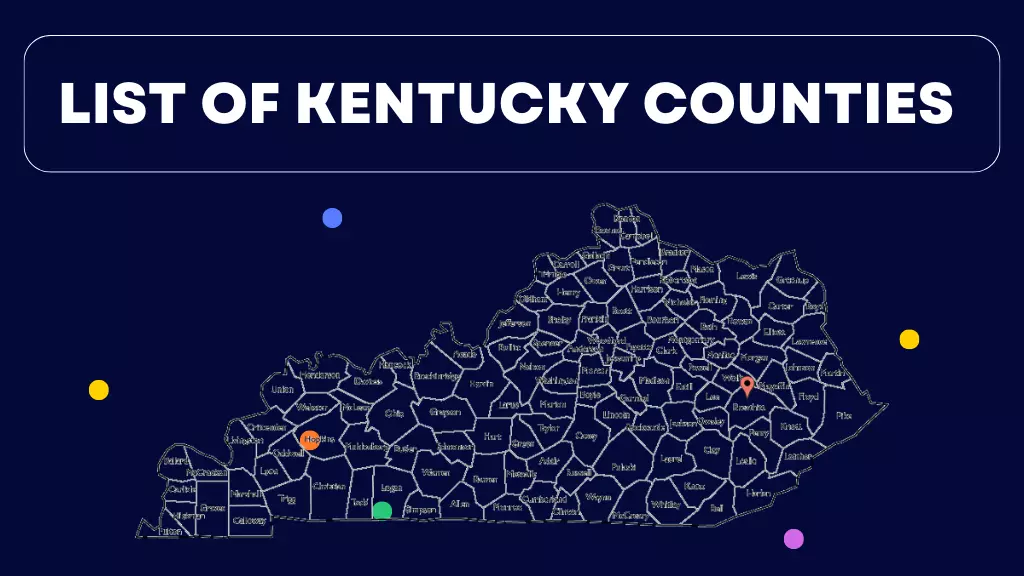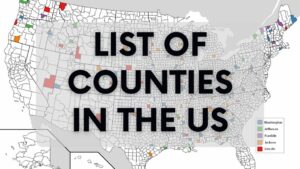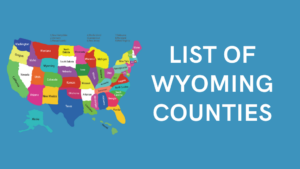Kentucky, famously known as the Bluegrass State, is home to 120 counties, making it one of the states with the highest number of counties in the nation. Each county represents a unique blend of history, geography, culture, and economy. Exploring the list of Kentucky counties helps us understand how local communities contribute to the state’s overall identity. From the bustling cities of Jefferson and Fayette to the rural charm of Robertson and Owsley, Kentucky’s counties reflect both diversity and unity.
Historical Background of Kentucky Counties
Kentucky became the 15th state of the Union in 1792 with only nine original counties. Over time, as settlements spread, counties were divided to make government services more accessible to residents. Many were named after Revolutionary War heroes, pioneers, and political leaders. Today, Kentucky’s county system plays a vital role in governance, education, and cultural preservation.
Complete List of Kentucky Counties
Adair County
Formed in 1801, Adair County lies in south-central Kentucky. Columbia, its county seat, is surrounded by rolling hills and agricultural land. The county is also near Lake Cumberland, a popular destination for outdoor recreation.
Allen County
Created in 1815, Allen County borders Tennessee. Its economy thrives on farming, particularly corn, soybeans, and tobacco. Scottsville serves as its county seat and a hub for small-town culture.
Anderson County
Established in 1827, Anderson County is well-known for its bourbon industry. The Wild Turkey distillery in Lawrenceburg is a symbol of the region’s heritage. Farming and local festivals also shape its economy.
Ballard County
Located in the western Jackson Purchase region, Ballard County sits at the meeting point of the Ohio and Mississippi Rivers. This makes it rich in river trade and fertile farmland. Wickliffe serves as its county seat.
Barren County
Formed in 1798, Barren County includes Glasgow, a vibrant small city. The area is known for its rich farmland and for being a gateway to Barren River Lake, which supports both tourism and recreation.
Bath County
Founded in 1811, Bath County was named for its mineral springs. Owingsville is its county seat, and the county’s scenic landscape supports agriculture and small-town life.
Bell County
Located in southeastern Kentucky, Bell County features the Cumberland Gap, a historic route for pioneers moving westward. Middlesboro is its largest city and an economic hub in the region.
Boone County
Part of Northern Kentucky, Boone County is one of the fastest-growing areas in the state. It includes the Cincinnati/Northern Kentucky International Airport and blends urban growth with suburban living.
Bourbon County
Formed in 1786, Bourbon County gave its name to the world-famous bourbon whiskey. Paris, the county seat, is surrounded by horse farms and Bluegrass landscapes, making it a hub of Kentucky tradition.
Boyd County
Located along the Ohio River in northeastern Kentucky, Boyd County includes Ashland, an industrial and cultural center. The area has strong ties to steelmaking and Appalachian heritage.
Boyle County
Established in 1842, Boyle County is home to Danville, where Kentucky’s constitution was drafted. It has a rich educational heritage, including Centre College, one of the state’s top institutions.
Breathitt County
Created in 1839, Breathitt County lies in Eastern Kentucky. Known for its Appalachian traditions, the county has a strong coal-mining history and close-knit rural communities.
Breckinridge County
Formed in 1799, Breckinridge County sits along the Ohio River. Hardinsburg is its county seat, and the area is rooted in agriculture, with corn and cattle production.
Bullitt County
Located south of Louisville, Bullitt County is famous for bourbon distilleries and the scenic Bernheim Arboretum. Shepherdsville serves as a growing suburban hub.
Butler County
Established in 1810, Butler County is largely rural and named after Revolutionary War General Richard Butler. Morgantown is the county seat, and farming dominates the local economy.
Caldwell County
Created in 1809, Caldwell County is home to Princeton, its county seat. Agriculture is central here, along with historical landmarks like Civil War battle sites.
Calloway County
Formed in 1822, Calloway County includes Murray, a thriving college town home to Murray State University. Tourism around Kentucky Lake also supports its economy.
Campbell County
Located along the Ohio River, Campbell County is part of the Cincinnati metro area. Newport and Alexandria are its main cities, offering both history and urban culture.
Carlisle County
Created in 1886, Carlisle County is one of the smallest in the state. Bardwell is the county seat, and the area is known for its farmland in the Jackson Purchase.
Carroll County
Located at the junction of the Kentucky and Ohio Rivers, Carroll County has a strong industrial base. Carrollton serves as the county seat and regional trade center.
Carter County
Formed in 1838, Carter County is located in northeastern Kentucky. Its Carter Caves State Resort Park attracts nature enthusiasts from across the state.
Casey County
Established in 1806, Casey County is famous for its Amish and Mennonite farming communities. Liberty is its county seat, and the county has a strong agricultural base.
Christian County
One of Kentucky’s largest counties, Christian is home to Hopkinsville and Fort Campbell, a major U.S. Army base. Agriculture and military presence drive its economy.
Clark County
Formed in 1792, Clark County is part of the Lexington metro region. Winchester serves as the county seat, blending history, culture, and modern development.
Clay County
Created in 1807, Clay County lies in Eastern Kentucky. Manchester is the county seat, and coal mining has historically shaped the county’s identity.
Clinton County
Located on the Tennessee border, Clinton County has Albany as its seat. It is a gateway to Lake Cumberland, making tourism an important industry.
Crittenden County
Formed in 1842, Crittenden County has Marion as its county seat. The area is notable for fluorite mining and strong agricultural traditions.
Cumberland County
Created in 1798, Cumberland County is located in southern Kentucky. Burkesville is the seat, and the county is known for the Cumberland River and outdoor tourism.
Daviess County
Situated on the Ohio River, Daviess County is famous for Owensboro, a center of bourbon production and bluegrass music. Agriculture and industry are also strong.
Edmonson County
Home to Mammoth Cave National Park, Edmonson County is world-renowned for its caves. Brownsville is the county seat, and tourism drives much of the economy
Elliott County
Formed in 1869, Elliott County is one of Kentucky’s smallest counties in population. Sandy Hook is its county seat, and the area is deeply rooted in Appalachian traditions. Farming and forestry form the backbone of the economy.
Estill County
Established in 1808, Estill County lies along the Kentucky River. Irvine, its county seat, is surrounded by scenic hills and natural beauty, making the county popular for outdoor recreation and small-town living.
Fayette County
Home to Lexington, Fayette County is central to Kentucky’s Bluegrass Region. Known worldwide for horse breeding and racing, it also houses the University of Kentucky, a major center of education and research.
Fleming County
Formed in 1798, Fleming County is called the “Covered Bridge Capital of Kentucky” due to its historic bridges. Flemingsburg, its seat, represents small-town Kentucky charm, with farming and tourism supporting the economy.
Floyd County
Located in Eastern Kentucky, Floyd County has Prestonsburg as its county seat. Once dependent on coal mining, the area today celebrates Appalachian culture through music, festivals, and heritage tourism.
Franklin County
Franklin County is home to Frankfort, the state capital of Kentucky. Beyond politics, the county thrives on bourbon distilling, education, and government services, making it one of the most influential counties in the state.
Fulton County
Located in far-west Kentucky along the Mississippi River, Fulton County is unique for its river-based trade. Hickman is its county seat, and agriculture remains central to its local economy.
Gallatin County
Created in 1798, Gallatin County sits along the Ohio River. Warsaw is its county seat, and the county is a mix of small-town life, farming, and river-based commerce.
Garrard County
Formed in 1796, Garrard County is part of central Kentucky’s Bluegrass region. Lancaster, the county seat, represents the agricultural traditions and historical heritage of the area.
Grant County
Located between Lexington and Cincinnati, Grant County is home to Williamstown and the Ark Encounter, a major tourist attraction. Farming and small businesses are also key to the economy.
Graves County
Founded in 1824, Graves County has Mayfield as its seat. The county has long been an agricultural hub, with corn, soybeans, and tobacco as main crops, along with a growing manufacturing base.
Grayson County
Located in central Kentucky, Grayson County is home to Rough River Lake and Nolin River Lake. Leitchfield, the county seat, benefits from both recreation and farming.
Green County
Formed in 1792, Green County is one of Kentucky’s oldest counties. Greensburg is its seat, and the county is historically important for its farming heritage and early settlement.
Greenup County
Located along the Ohio River, Greenup County has Greenup as its seat and Ashland nearby as a cultural hub. The area blends Appalachian traditions with river-based trade and industry.
Hancock County
Created in 1829, Hancock County lies along the Ohio River. Hawesville is its county seat, and the county is known for aluminum manufacturing and agriculture.
Hardin County
Home to Elizabethtown and Fort Knox, Hardin County is one of the state’s most significant counties. Its economy combines military presence, commerce, and suburban growth.
Harlan County
Located deep in the Appalachian Mountains, Harlan County has a proud coal-mining history. Harlan, its seat, symbolizes resilience, and the county is rich in Appalachian culture.
Harrison County
Formed in 1793, Harrison County has Cynthiana as its county seat. The county blends farming traditions with small-town culture and is known for its historic architecture.
Hart County
Home to part of Mammoth Cave National Park, Hart County is scenic and rural. Munfordville serves as its county seat, and tourism plays a key role in the local economy.
Henderson County
Situated on the Ohio River, Henderson County is known for both agriculture and industry. Henderson, the county seat, has a vibrant arts and cultural scene.
Henry County
Formed in 1798, Henry County has New Castle as its seat. Its economy is largely agricultural, with corn and livestock farming playing major roles.
Hickman County
Located in far-west Kentucky, Hickman County borders the Mississippi River. Clinton is its seat, and farming dominates the landscape, with strong community ties.
Hopkins County
Established in 1806, Hopkins County includes Madisonville, its seat. The county has historically relied on coal mining but today is diversifying into manufacturing and commerce.
Jackson County
Formed in 1858, Jackson County is a rural Appalachian county with McKee as its seat. The area is known for natural beauty, farming, and traditional mountain culture.
Jefferson County
Jefferson County includes Louisville, Kentucky’s largest city. As the state’s economic hub, it thrives in industries like healthcare, logistics, bourbon, and horse racing, making it the most populous and diverse county.
Jessamine County
Located in central Kentucky, Jessamine County is part of the Lexington metro area. Nicholasville is the county seat, and horse farms, bourbon production, and scenic countryside define its character.
Johnson County
Formed in 1843, Johnson County lies in Eastern Kentucky. Paintsville, its seat, is known for its music heritage, being home to country stars like Loretta Lynn and Chris Stapleton.
Kenton County
Part of Northern Kentucky, Kenton County includes Covington and Independence. It is a key part of the Cincinnati metro, with strong industry, culture, and river commerce.
Knott County
Located in Eastern Kentucky, Knott County is rich in Appalachian traditions. Hindman is its county seat, and the area is known for arts, crafts, and a history of coal mining.
Knox County
Formed in 1799, Knox County includes Barbourville as its county seat. Historically important for pioneer settlement, it is largely rural with a mix of farming and coal heritage.
LaRue County
Best known as the birthplace of Abraham Lincoln, LaRue County has Hodgenville as its seat. Tourism tied to Lincoln’s legacy complements its agricultural economy.
Laurel County
Located in southeastern Kentucky, Laurel County includes London as its seat. It is famous as the birthplace of Kentucky Fried Chicken, and also serves as a regional economic hub.
Lawrence County
Bordering West Virginia, Lawrence County has Louisa as its seat. Its culture is strongly Appalachian, with a mix of farming, coal, and river-based commerce.
Lee County
Formed in 1870, Lee County is a small Eastern Kentucky county with Beattyville as its seat. It is known for rugged mountain landscapes and outdoor recreation.
Leslie County
Created in 1878, Leslie County has Hyden as its seat. Coal mining defined much of its history, and the county remains rooted in Appalachian traditions.
Letcher County
Located in Eastern Kentucky, Letcher County has Whitesburg as its seat. It is known for its coal-mining heritage and natural mountain beauty, including outdoor trails.
Lewis County
Situated along the Ohio River, Lewis County is one of Kentucky’s most scenic. Vanceburg is its county seat, and the county thrives on farming, forestry, and outdoor tourism.
Lincoln County
Formed in 1780, Lincoln County is one of Kentucky’s original counties. Stanford is the county seat, and the county has deep agricultural traditions and early settlement history.
Livingston County
Located in western Kentucky, Livingston County has Smithland as its county seat. The Ohio River and nearby natural areas give it a strong identity tied to trade and recreation.
Logan County
Established in 1792, Logan County is historically important in Kentucky’s agricultural economy. Russellville is the county seat, and the county remains strong in farming and small industry.
Lyon County
Located in western Kentucky, Lyon County includes Eddyville as its seat. It is home to part of the Land Between the Lakes National Recreation Area, a major tourism draw.
Madison County
Home to Richmond, Madison County is a significant educational and cultural hub. It hosts Eastern Kentucky University and blends agriculture, commerce, and suburban growth.
Magoffin County
Created in 1860, Magoffin County is located in Eastern Kentucky with Salyersville as its seat. The county is known for its Appalachian roots, coal heritage, and scenic landscapes.
Marion County
Established in 1834, Marion County has Lebanon as its seat. It is famous for bourbon production, including the Maker’s Mark distillery, and represents central Kentucky culture.
Marshall County
Located in western Kentucky, Marshall County includes Benton as its county seat. Tourism tied to Kentucky Lake and outdoor recreation is a big part of its economy.
Martin County
Formed in 1870, Martin County sits along the West Virginia border. Inez is its seat, and the county has a strong Appalachian identity with a coal-mining history.
Mason County
Established in 1788, Mason County lies along the Ohio River with Maysville as its seat. The county is historically important in trade and is rich in cultural heritage.
McCracken County
Home to Paducah, McCracken County is a western Kentucky hub. The city thrives on arts, river commerce, and regional industry, making it one of the state’s most dynamic areas.
McCreary County
Created in 1912, McCreary County is located in southeastern Kentucky. Whitley City serves as the county seat, and the county is known for its forests, outdoor tourism, and rural culture.
McLean County
Established in 1854, McLean County has Calhoun as its seat. The county economy centers on farming, small-town commerce, and community traditions.
Meade County
Located along the Ohio River, Meade County includes Brandenburg as its seat. Its economy is a mix of agriculture, military influence from nearby Fort Knox, and local industry.
Menifee County
Formed in 1869, Menifee County is a small rural area in Eastern Kentucky. Frenchburg is its seat, and the county is recognized for natural beauty and outdoor recreation.
Mercer County
Established in 1785, Mercer County has Harrodsburg as its seat. It is one of Kentucky’s oldest settlements and is important for bourbon, farming, and history.
Metcalfe County
Created in 1860, Metcalfe County includes Edmonton as its seat. Farming dominates the economy, while the county remains strongly tied to its rural traditions.
Monroe County
Formed in 1820, Monroe County has Tompkinsville as its seat. Agriculture, especially livestock and tobacco, plays a key role in its economy, along with small-town heritage.
Montgomery County
Located in central Kentucky, Montgomery County has Mount Sterling as its seat. It blends small-town culture with agriculture and growing commerce.
Morgan County
Established in 1822, Morgan County lies in Eastern Kentucky. West Liberty is its seat, and the county is rich in Appalachian traditions and outdoor resources.
Muhlenberg County
Known for its coal-mining history, Muhlenberg County was established in 1798. Greenville is the county seat, and music heritage also defines the community.
Nelson County
Formed in 1784, Nelson County is home to Bardstown, often called the “Bourbon Capital of the World.” Its economy thrives on bourbon, tourism, and historic sites.
Nicholas County
Established in 1799, Nicholas County has Carlisle as its seat. The county is mainly agricultural, with a strong sense of small-town community life.
Ohio County
Created in 1799, Ohio County has Hartford as its seat. Once a coal-mining hub, the county now has a mix of farming, small industries, and Appalachian culture.
Oldham County
Located near Louisville, Oldham County includes La Grange as its seat. It is known for strong schools, suburban communities, and a blend of agriculture and modern living.
Owen County
Established in 1819, Owen County has Owenton as its seat. The county is known for its farming traditions, rural charm, and community spirit.
Owsley County
Formed in 1843, Owsley County is one of the smallest by population in Kentucky. Booneville is its seat, and the county is deeply tied to Appalachian heritage.
Pendleton County
Located in Northern Kentucky, Pendleton County has Falmouth as its seat. Farming and river valleys define its economy, along with a rural, close-knit community.
Perry County
Formed in 1821, Perry County is an Eastern Kentucky county with Hazard as its seat. Coal mining played a key role in its development, and Appalachian traditions remain strong.
Pike County
The largest county in Kentucky by land area, Pike County has Pikeville as its seat. Rich in coal history, it is also a hub for Appalachian culture, music, and education.
Powell County
Established in 1852, Powell County has Stanton as its seat. It is home to the Red River Gorge, one of Kentucky’s top natural attractions, making tourism essential.
Pulaski County
Created in 1799, Pulaski County has Somerset as its seat. With Lake Cumberland nearby, the county thrives on tourism, recreation, and a growing local economy.
Robertson County
Established in 1867, Robertson County is the smallest by population in Kentucky. Mount Olivet is its county seat, and the area is known for its rural character, farming, and quiet living.
Rockcastle County
Formed in 1810, Rockcastle County has Mount Vernon as its seat. The county is named after Rockcastle River and is known for outdoor recreation, farming, and Appalachian heritage.
Rowan County
Created in 1856, Rowan County includes Morehead as its seat. The county is famous for Morehead State University and the Daniel Boone National Forest, which attract both students and visitors.
Russell County
Located in south-central Kentucky, Russell County has Jamestown as its seat. The county is home to Lake Cumberland, making tourism and water recreation a major part of the economy.
Scott County
Formed in 1792, Scott County has Georgetown as its county seat. The area combines agriculture with industry and is home to Toyota’s large manufacturing plant in Georgetown.
Shelby County
Established in 1792, Shelby County includes Shelbyville as its seat. Known as the “Saddlebred Horse Capital of the World,” the county has deep ties to horse breeding and farming.
Simpson County
Created in 1819, Simpson County has Franklin as its seat. Located on the Kentucky Tennessee border, it has a mix of agriculture, manufacturing, and cross-border trade.
Spencer County
Formed in 1824, Spencer County has Taylorsville as its county seat. The county is known for Taylorsville Lake, which supports tourism and outdoor activities, alongside traditional farming.
Taylor County
Established in 1848, Taylor County includes Campbellsville as its seat. The county is known for Campbellsville University and Green River Lake, both of which are central to its identity.
Todd County
Created in 1820, Todd County has Elkton as its seat. The county is largely agricultural, with fertile farmland supporting crops like tobacco, corn, and soybeans.
Trigg County
Located in western Kentucky, Trigg County has Cadiz as its seat. It is known for its location near Land Between the Lakes National Recreation Area, boosting tourism and outdoor recreation.
Trimble County
Formed in 1837, Trimble County includes Bedford as its county seat. Situated along the Ohio River, the county has a rural economy centered on farming and river trade.
Union County
Established in 1811, Union County has Morganfield as its seat. The county is known for its coal mining, agriculture, and strong ties to the Ohio River economy.
Warren County
Located in south-central Kentucky, Warren County has Bowling Green as its seat. It is one of the fastest-growing counties in Kentucky, with Western Kentucky University and a strong industrial base.
Washington County
Formed in 1792, Washington County has Springfield as its county seat. It is Kentucky’s first county created after statehood and has a strong agricultural tradition and Catholic heritage.
Wayne County
Created in 1800, Wayne County includes Monticello as its seat. Located near Lake Cumberland, the county benefits from tourism, outdoor recreation, and farming.
Webster County
Established in 1860, Webster County has Dixon as its seat. The area is historically tied to coal mining and farming, with a small-town atmosphere.
Whitley County
Located in southeastern Kentucky, Whitley County has Williamsburg as its county seat. The county is home to part of Cumberland Falls State Park, making it a scenic and historic destination.
Conclusion
The list of Kentucky counties reflects the state’s rich history, diverse culture, and unique regional characteristics. From the bustling economic centers like Jefferson and Fayette counties to the rural charm of Robertson and Owsley counties, each region tells its own story. Kentucky’s counties are tied together by traditions of farming, coal mining, horse breeding, bourbon production, and cultural heritage that shape the Bluegrass State’s identity. Whether you are exploring its scenic lakes, studying its historical towns, or seeking opportunities in its growing urban centers, Kentucky’s counties provide a complete picture of a state that balances tradition with progress. Understanding this full list of counties not only helps in learning geography but also offers insights into Kentucky’s economy, lifestyle, and attractions.
FAQs
How many counties are in Kentucky?
Kentucky has a total of 120 counties, making it one of the U.S. states with the largest number of counties.
Which is the largest county in Kentucky by area?
Pike County is the largest county in Kentucky by land area, located in the eastern region of the state.
Which county in Kentucky has the highest population?
Jefferson County, home to Louisville, is the most populated county in Kentucky.
What is the smallest county in Kentucky?
Robertson County is the smallest in terms of population, with fewer than 2,500 residents.
Related Post:





